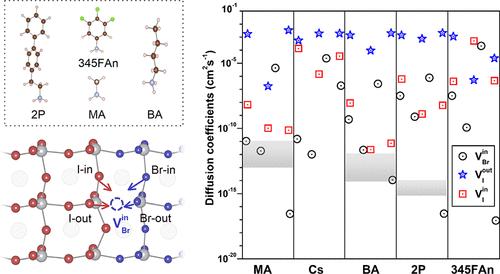First-Principles Study of Anionic Diffusion in Two-Dimensional Lead Halide Perovskite Lateral Heterostructures
IF 8.2
2区 材料科学
Q1 MATERIALS SCIENCE, MULTIDISCIPLINARY
引用次数: 0
Abstract
Perovskite heterostructures have attracted wide interest for their photovoltaic and optoelectronic applications. The interdiffusion of halide anions leads to the poor stability and shorter lifetime of the halide perovskite heterostructures. Covering organic cations on the surface of perovskite heterostructures, the diffusion of ions can effectively be suppressed. However, the migration mechanism on two-dimensional lead halide perovskite lateral heterostructures under different organic cations remains inadequately explored. In this work, we performed first-principles calculations on the ion migration in two-dimensional (2D) lead halide perovskite lateral heterostructures with different interface defects and different cations. We found that the migration of iodine atoms across the interface in the heterostructures is more preferable than that of bromine atoms, regardless of the cations. Meanwhile, the migration of iodine atoms from the in-plane to the out-plane direction has the lowest energy barrier compared to other directions. Our calculations also reveal that both the type of cation and the migration path selected affect the energy barrier for anion migration, exhibiting either inhibitory or promoting effects. Specifically, the organic cation 345FAn, an ammonium ligand, showed an excellent promoting effect on the anion migration, while the BA cation exhibited an inhibiting effect. The calculated interdiffusion rate includes the interfacial single bromine vacancy, which is consistent with previous experimental observations. However, the heterostructures with interfacial single iodine defects exhibit a higher interdiffusion rate. Our findings on the ion migration mechanism in lead halide perovskite lateral heterostructures contribute to both experimental discussions and theoretical insights.

二维卤化铅钙钛矿横向异质结构中阴离子扩散的第一性原理研究
过氧化物异质结构因其光伏和光电应用而受到广泛关注。卤化物阴离子的相互扩散导致卤化物过氧化物异质结构稳定性差、寿命短。在包晶异质结构表面覆盖有机阳离子可以有效抑制离子的扩散。然而,不同有机阳离子在二维卤化铅包晶石侧向异质结构上的迁移机制仍未得到充分探索。在这项工作中,我们对具有不同界面缺陷和不同阳离子的二维卤化铅包晶石侧向异质结构中的离子迁移进行了第一性原理计算。我们发现,在异质结构中,无论阳离子如何,碘原子在界面上的迁移比溴原子的迁移更有利。同时,与其他方向相比,碘原子从平面内向平面外迁移的能垒最低。我们的计算还表明,阳离子的类型和选择的迁移路径都会影响阴离子迁移的能垒,表现出抑制或促进作用。具体来说,有机阳离子 345FAn(一种铵配体)对阴离子迁移有极好的促进作用,而 BA 阳离子则表现出抑制作用。计算出的相互扩散率包括界面单个溴空位,这与之前的实验观察结果一致。然而,具有界面单个碘缺陷的异质结构表现出更高的相互扩散率。我们对卤化铅包晶石侧向异质结构中离子迁移机制的研究结果,既有助于实验讨论,也有助于理论洞察。
本文章由计算机程序翻译,如有差异,请以英文原文为准。
求助全文
约1分钟内获得全文
求助全文
来源期刊

ACS Applied Materials & Interfaces
工程技术-材料科学:综合
CiteScore
16.00
自引率
6.30%
发文量
4978
审稿时长
1.8 months
期刊介绍:
ACS Applied Materials & Interfaces is a leading interdisciplinary journal that brings together chemists, engineers, physicists, and biologists to explore the development and utilization of newly-discovered materials and interfacial processes for specific applications. Our journal has experienced remarkable growth since its establishment in 2009, both in terms of the number of articles published and the impact of the research showcased. We are proud to foster a truly global community, with the majority of published articles originating from outside the United States, reflecting the rapid growth of applied research worldwide.
 求助内容:
求助内容: 应助结果提醒方式:
应助结果提醒方式:


